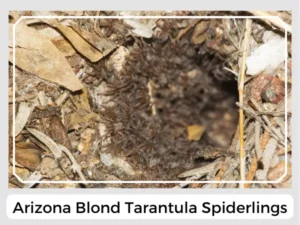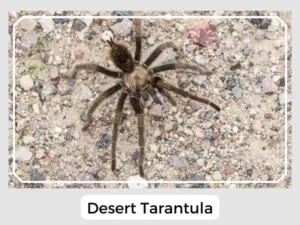The Arizona blond tarantula is a special spider found mainly in Arizona’s deserts and some places in Mexico. They live longer than many other tarantulas and are super calm. That’s why lots of people who like spiders choose them as pets. Let’s learn some cool facts about them right here!
The number of eggs a female spider lays in her life could be up to 200.
After the hatching, the young spiders stay inside the burrows and then disperse on their own after a particular time.

Photo Credit: C.Allen
They don’t make webs as such, but the entrance of their burrows is covered with multiple silk threads acting as entrapment for potential prey.
They are not harmful to humans, but their bite could result in irritation, allergy, and a stinging sensation in people.
These spiders are very docile. However, they can bite if they feel threatened. The bite might feel like a little pinch, but most folks don’t find it too bothersome.
Arizona blond tarantulas play a crucial role in their desert ecosystems. As predators, they help control the populations of insects and other small animals, contributing to the balance of their environment. Their burrowing behavior also aids in soil aeration, promoting healthier plant growth. These spiders are nocturnal, emerging from their burrows at night to hunt and explore while seeking refuge underground during the heat of the day.
Natural Predator: Birds, especially larger species, are among the main natural predators of the Arizona blond tarantula. They also face threats from mammals like coyotes and skunks, as well as other larger arachnids.
Prey-Predator Dynamics: Arizona blond tarantulas primarily feed on crickets and other insects, which they ambush from their burrows. They rely on their silk-lined burrows not just for protection, but also as a means to sense the presence of prey and potential threats.
Relationship with Humans: Despite their venomous nature, Arizona blond tarantulas are generally considered harmless to humans. Their calm demeanor has made them a favorite among pet owners, and they often serve as ambassadors for their species, helping to dispel common misconceptions about spiders.
| Other Names | Mexican blond tarantula, desert tarantula, western desert tarantula |
| Distribution | Arizona, Mexico |
| Habitat | Desert |
| Diet | Crickets and insects |
| Lifespan | Females: 30 years maximum Males: 5-10 years |
| IUCN Conservation Status | Not Listed |
Its common name blond tarantula has come from the copper-colored hair on its carapace.
In summary, the Arizona blond tarantula is a remarkable spider, embodying the resilience and adaptability necessary to thrive in the harsh desert environment.

The Arizona blond tarantula is a special spider found mainly in Arizona’s deserts and some places in Mexico. They live longer than many other tarantulas and are super calm. That’s why lots of people who like spiders choose them as pets. Let’s learn some cool facts about them right here!
The number of eggs a female spider lays in her life could be up to 200.
After the hatching, the young spiders stay inside the burrows and then disperse on their own after a particular time.

Photo Credit: C.Allen
They don’t make webs as such, but the entrance of their burrows is covered with multiple silk threads acting as entrapment for potential prey.
They are not harmful to humans, but their bite could result in irritation, allergy, and a stinging sensation in people.
These spiders are very docile. However, they can bite if they feel threatened. The bite might feel like a little pinch, but most folks don’t find it too bothersome.
Arizona blond tarantulas play a crucial role in their desert ecosystems. As predators, they help control the populations of insects and other small animals, contributing to the balance of their environment. Their burrowing behavior also aids in soil aeration, promoting healthier plant growth. These spiders are nocturnal, emerging from their burrows at night to hunt and explore while seeking refuge underground during the heat of the day.
Natural Predator: Birds, especially larger species, are among the main natural predators of the Arizona blond tarantula. They also face threats from mammals like coyotes and skunks, as well as other larger arachnids.
Prey-Predator Dynamics: Arizona blond tarantulas primarily feed on crickets and other insects, which they ambush from their burrows. They rely on their silk-lined burrows not just for protection, but also as a means to sense the presence of prey and potential threats.
Relationship with Humans: Despite their venomous nature, Arizona blond tarantulas are generally considered harmless to humans. Their calm demeanor has made them a favorite among pet owners, and they often serve as ambassadors for their species, helping to dispel common misconceptions about spiders.
| Other Names | Mexican blond tarantula, desert tarantula, western desert tarantula |
| Distribution | Arizona, Mexico |
| Habitat | Desert |
| Diet | Crickets and insects |
| Lifespan | Females: 30 years maximum Males: 5-10 years |
| IUCN Conservation Status | Not Listed |
Its common name blond tarantula has come from the copper-colored hair on its carapace.
In summary, the Arizona blond tarantula is a remarkable spider, embodying the resilience and adaptability necessary to thrive in the harsh desert environment.
